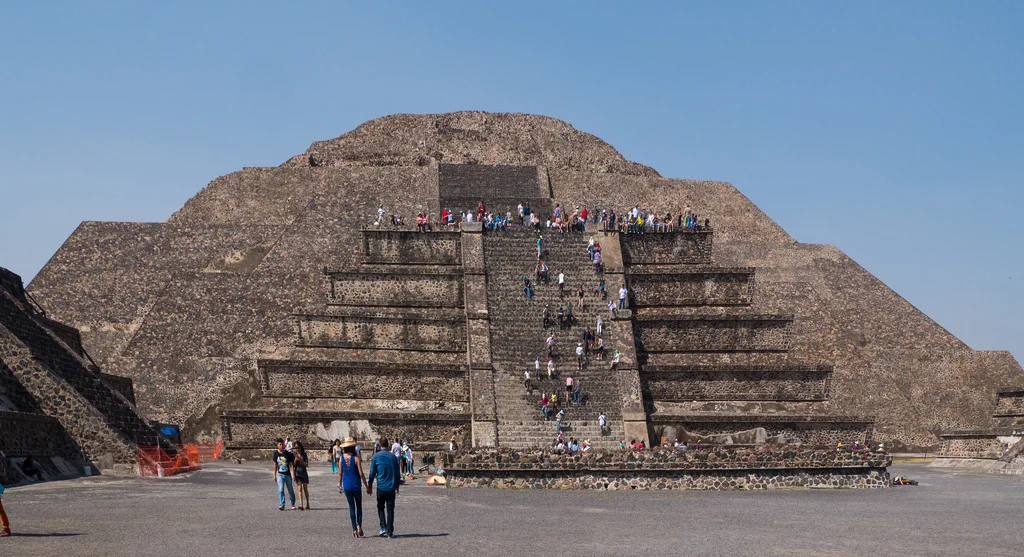DAY 1: Rest in Peace - or Pieces (Coyoacan and Xochimilco)
Museo casa estudio (Studio house museum) diego rivera and Frida Kahlo
After returning from the US, following Diego Rivera's multi-city artist residency, Diego and Frida settled down in their own adjacent homes, connected to one another by bridge. Apparently even that was too close for comfort since they divorced a few years later. Frida moved just a few miles away back to her famous family-home Casa Azul, and apparently that was the appropriate distance for their relationship since Diego came crawling back. He lived with her in Casa Azul, keeping his former residence as a studio until Frida died a few years later. Diego moved back here, where he died some years later. The studio is preserved just as he left it.
Frida kahlo museum
You may have noticed that Frida's house in Diego's complex was mostly bare of her belongings, most likely because she felt more at home here in The Blue House, where she was born, as well as where she died. In the latter part of his life, she lived here not only with Diego Rivera, but also with Leon Trotsky and his wife Natalia Sedova, and a ever-revolving cast of other far-leftist characters. Trotsky lived here for two years before he had a falling out with Diego over their political ideologies. You're not really supposed to discuss politics with your guests at the dinner table, but I suppose when your guests live with you for two years, it's unavoidable.
bonus: leon trotsky museum
If you have trouble holding back your political opinions, you may have been more comfortable here in the home of Leon Trotsky, to which he moved after his fall out with Diego Rivera. Trotsky came to a slightly less peaceful ending than either Diego or Frida, being that he was assassinated in this very home by an agent of Stalin via ice pick to the head. (Trotsky was famously banished from the Soviet Union after a power struggle with Stalin.) While visiting this house, you'll find plenty artifacts from his life, as well as bullet holes from a previous attempt on his life, and a tomb which contains his ashes.
coyoacan market
This is probably one of the best market experiences you can possibly have while in Mexico City. Here you'll find everything from delicious home-cooked food to discounted home-made crafts. If you've been meaning to try some bugs while in Mexico, you can buy them in bulk here, in various flavors such as BBQ and Salt & Vinegar, to eat on the go. If you don't feel like eating bugs today or really any day, you'll find plenty othr options, including some of the best tostadas you'll ever have in your life, pictured above.
floating gardens of xochimilco
Take a relaxing ride on one these colorful trajineras, or canoes, which take you through the various floating gardens of Xochimilco. Along the way, you'll pass some beautifully-rustic homes, gardens and curiosities, such as the Island of the Dolls. (See post below.) It's not an entirely peaceful ride, as various vendor-canoes will float alongside you in attempt to sell you various foods, goods and experiences, such as a floating mariachi performance. Everything here is good quality and inexpensive, so if you have the money, it doesn't hurt to support the locals or to donate, especially considering these canals are under threat of drying up completely.
island of the dead dolls
According to legend, the body of a young girl washed up on the shores of this island in the mid 20th century. Her body was found by the caretaker of the island, who also found her doll and hung it up to honor her spirit. Apparently haunted by the doll, which he believed was possessed by the spirit of the girl, he spent the next 50 years hanging dolls to appease the dead girl's spirit. After his death, locals and tourists continue the tradition by hanging up their own dolls, and parts of dolls, to add to the chilly atmosphere. It's quite a creepy spectacle, especially after sunset, when locals say they sometimes hear the dolls whispering to one another or moving their limbs. For the brave souls that want to visit this island, you'll have to make sure that your specific trajinera (see post above) can take you there. If you'd rather see it from a safe distance, any trajinera will slowly drift right past the island.
STAY THE NIGHT IN: Mexico city
DAY 2: Pyramid Pilgrims (Teotihuacan)
teotihuacan
This once massive Mesoamerican city, the largest in all the Americas and the sixth largest city in the world at its peak in the first millennium AD, was once inhabited by various tribes and may have been a mutli-ethnic city. It was mostly abandoned when the Aztecs found it over a thousand years later. It became an Aztec pilgrimmage site, as they believed the universe began here, and they were the ones that gave the structures the names we refer to them today.
pyramid of the sun
Likely the first thing you'll see in the distance when you embark on the long walk between the parking lot and the complex is this massive pyramid, the third largest in the world. Try not to get distracted by the long row of vendors along the way, unless you want to. The goal is to arrive here as early as possible to avoid the long line wrapping around the pyramid; you'll want to save your frustrations for the 200 foot steep-stair ascent, which becomes even tougher at this elevation, along with the sun beating down your neck. It's worth the effort though to make this once in a lifetime pilgrimage.
Templo de Quetzalcoatl
Once you walk down from the Pyramid of the Sun, take your time walking south along the Avenue of the Dead toward this much less imposing, though equally interesting archaeological site, a temple dedicated to Quetzalcoatl, the feathered serpent god. Also called La Ciudadela by Spanish conquistadors, it has some of the most well preserved murals and sculptures of all the other pyramids in the complex. It's also a lot less crowded.
pyramid of the moon
At the northern end of the Avenue of the Dead, you can climb this medium sized pyramid, which judging by the remains that were found here, was probably used for human sacrifices. It's also a nice spot to see the sunset or the stars if you're around later in the day. If you're not up for the hike up, you could also see various archeological curiosities nearby like the Palace of Quetzalcoatl, the Temple of the Jaguars, a mural of a Puma, and a museum exhibiting various murals found in this city.
STAY THE NIGHT IN: Mexico City
DAY 3: Increasingly Tall Structures (Tula and Tepotzotlan)
Zona Arqueologica de tulA
Another noteworthy Mesoamerican complex, Tula served as the capital of the Toltec empire, centuries after Teotihuacan's fall. It's much less studied than Teotihuacan and also much-less visited, which makes for a more memorable experience. The central item to see here is Pyramid B, also dedicated to Quetzalcoatl, the feathered serpent god (this guy got around). The pyramid is topped by massive columns depicting Toltec warriors, which also served as structural supports for the temple that once stood atop this pyramid. This columns are super imposing from the front, but not so much from the back, with their perky butt cheeks exposed.
Tepotzotlan
On the way back from Tula to Mexico City, a short detour will take you to this beautifully-preserved New Spanish town, which was once home to the Otomi people, centuries prior. In the center of the town you'll find The Museum of the Viceroyalty of New Spain, a former Jesuit school which was one of the most prominent educational centers in all of New Spain. Inside you can see beautiful altars, sit in one of the many peaceful chapels or courtyards, and tour their impressive 16th-20th century religious art collection.
Arcos site
Also known as the Arcos de Sitio, named after the gorge it traverses, this aqueduct is the tallest of it's kind in Latin America. It was built by the Jesuits between the 18th and 19th centuries to carry water to Tepotzotlan, where they studied. So not only were these Jesuits smart, they must've also been pretty fit. But don't get too excited ladies - they were in a committed relationship with God.












